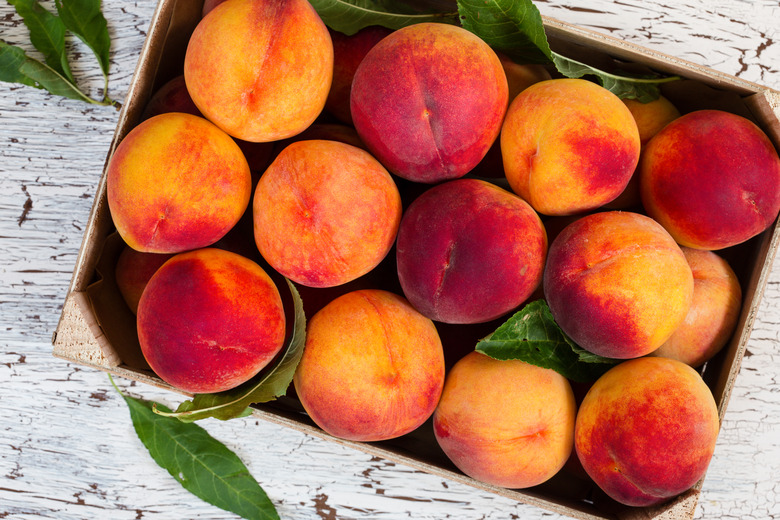Sweetest Peach Varieties
We may receive a commission on purchases made from links.
The luxurious flavor of peaches (Prunus persica) ranges from tangy-sweet to melt in your mouth sugary sweetness. The best peach varieties for a home orchard may vary according to your personal taste and local growing conditions. Peaches are hardy in U.S. Department of Agriculture plant hardiness zones 4 through 10 depending on the cultivar, and the sweetness of the fruits depends on the variety, the care of the tree, and allowing the fruits to ripen on the tree.
Sweetest Peaches in the World
Sweetest Peaches in the World
The sweetest peaches in the world are grown by Furuyama Kōji at Furuyama Fruit Farm in the central Fukushima Prefecture of Japan. The success of Kōji's peaches lies in part to his selection of a naturally sweet cultivar and his 15-year effort to improve the soil as well as pruning, providing sufficient water and fertilizer, thinning the tiny green fruits at the correct time, and allowing the peaches to fully ripen on the tree before harvesting.
The sweetness of peaches and other fruits is measured with a refractometer. This device measures the plant juices to determine the mineral and sugar ratio, with the percentage of the sugar or sucrose known as "degree Brix." The highest measure on the Brix scale is 40 degrees.
Kōji's Akatsuki Neo (Prunus persica 'Akatsuki Neo') peaches weigh in at an astounding 32 degrees Brix. In contrast, the average peaches found in a grocery store range from 11 to 15 degrees Brix. However, grocery store peaches are picked before they are fully ripe so they can be stored and transported; the sugar level may be underestimated when compared to tree-ripened fruits of the same cultivars. Peaches don't reach their full flavor and sweetness if they are not allowed to finish ripening on the tree.
White Peach Cultivars
White Peach Cultivars
White peaches tend to be sweeter than yellow-fleshed peaches, ranging from 12 to 16 degrees Brix. Among the sweetest cultivars is Saturn (Prunus persica 'Saturn'), a small donut peach that measures at 14 to 16 degrees Brix. The heirloom Indian Free peach (Prunus persica 'Indian Free') is also very sweet, reaching up to 20 degrees Brix under ideal conditions. White Lady (Prunus persica 'White Lady') and Snow Beauty (Prunus persica 'Snow Beauty') are also well known for their low-acid, high-sugar fruits.
In general, these cultivars thrive in USDA zones 5 through 9, though Snow Beauty prefers USDA zones 6 through 9. Unlike most peach cultivars, Indian Free requires a compatible pollinator, so plant a second different cultivar that blooms at the same time to ensure a good harvest.
Yellow Peach Cultivars
Yellow Peach Cultivars
Yellow peaches are also sweet, often with a higher acid level that gives the fruits just a hint of tangy flavor to offset the sweetness. If space is at a premium, the best peach varieties include Empress (Prunus persica 'Empress') and Honey Babe (Prunus persica 'Honey Babe'), which are natural dwarf trees that produce extra-sweet fruits in USDA zones 5 and 6 through 8 and 9, respectively. You can grow dwarf peach trees in containers on the patio and move them indoors if necessary.
The average backyard can support several semidwarf trees or one to two standard fruit trees. Harken (Prunus persica 'Harken') and the heirloom Elberta (Prunus persica 'Elberta') produce sweet medium to large freestone fruits in USDA zones 5 through 9. While peaches are generally self-fertile, plant two trees for a better harvest.
Peach Tree Care
Peach Tree Care
The best-tasting peaches in the world may vary according to your own taste buds, but you can encourage your trees to produce sweeter fruit with proper care. Select a cultivar suited to your USDA zone and plant the peach tree in late winter or early spring. Choose a sunny, well-drained location.
Space dwarf trees 10 to 12 feet apart and standard trees 15 to 20 feet apart. Water when the soil is dry to a depth of 2 to 4 inches and fertilize regularly. Thin the fruits when they're the size of a walnut, spacing them approximately 5 inches apart. Peach trees must be pruned every year, as the fruits develop on second-year growth.
Allow the fruits to fully ripen on the tree. When the peach is fully colored and sweet-smelling, gently squeeze it and if it's soft, the fruit is ready. The peach should easily come off the tree with just a twist of the wrist. If you have to cut the stem, the peach isn't ripe, so wait a few more days.
